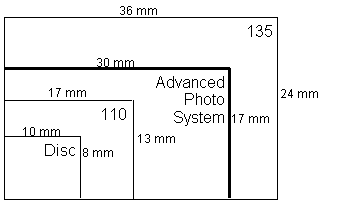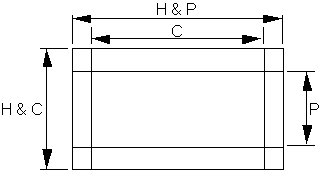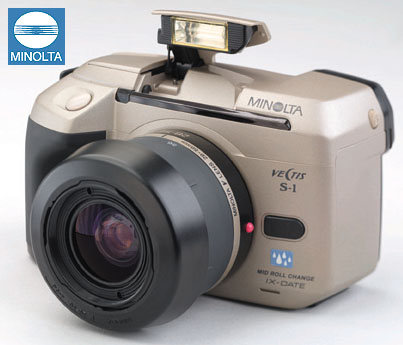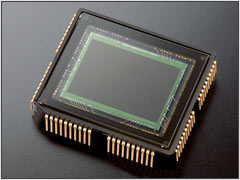Digital Photography from 20,000 Feet
by Wesley Fink on September 25, 2006 12:05 AM EST- Posted in
- Digital Camera
The Digital SLR
Several factors delayed the move to SLR technology for digital photography. First, the early sensors were much lower megapixel resolutions, far too low to begin to compete with film photography. Photo hobbyists saw few advantages to moving to a low resolution system since the reason they used an SLR was high image quality. It wasn't until resolutions reached the 2 to 4 megapixel range that there was any interest in a digital SLR.
Second, the early sensors were very small, developed primarily for video usage. Some tried to develop proprietary systems based on a smaller sensor size with more compact lenses, but nothing caught on in the industry. The cost of early sensors was also astronomical, making the early digital SLR cameras only useful for production, high volume photography where the cost could be justified.
Third, with sensor resolution and size in constant development it was much easier to design a point-and-shoot camera around each new sensor generation. Until sensor size stabilized, a digital SLR that used existing lens systems was not practical.
APS (Advanced Photo System)
35mm first appeared on the scene in the 1930s and the film format simply took 35mm motion picture film and spooled it into a light-tight canister. By the 1960s, with point-and-shoot and developments in SLR technology, 35mm had become king of the film formats. Even as film manufacturers tried to introduce other film formats, 35mm continued to grow and prosper. With the very early developments in digital photography, Kodak, Fuji and others saw the handwriting on the wall for film photography. One of the ongoing complaints about 35mm film, however, has been that the 2:3 image format required image loss in almost every standard print size. 8x10 and 5x7 are neither a 2:3 ratio and both required cropping of the 35mm negative.

In 1996 a new APS (Advanced Photo System) initiative by Kodak, Fujifilm, Minolta, Nikon, Canon and others was introduced to save film by standardizing on new ratios and adding new "computer-like" data storage capabilities in the taking and processing of images. APS included a new film size - 30.2mm x 16.7mm - that could be printed full-frame (H or HDTV format), or use standard crops of 25.1mm x 16.7mm (C or Classic 2:3 format) or 9.5mm x 30.2mm (P or Panorama). Actually, the image size that was always shot was the 30.2mm x 16.7mm, and the other sizes were just standard crops.

The industry was confident they could sell APS, which in the most common C view was only about 55% of the already small 35mm size. Some manufacturers like Minolta developed new APS lens lines with smaller cameras and lenses, and Canon and Nikon developed APS camera bodies that could mount their regular lenses - and a few custom APS lenses.

In the end, APS failed in the film market, but it is important in our discussion of Digital Photography because it was also a standard for digital development. At the time of the APS initiatives, it seemed reasonable to aim for development of digital sensors for that same APS format, so lenses for both systems were interchangeable. The industry aimed for the APS C size sensor, which would be about 16.7mm x 25.1mm the same ratio (2:3) as the classic 35mm format. This allowed existing 35mm lenses to be used, with a lens factor of 1.5 to 1.6, and the development of new lenses with a smaller image circle.
What do we mean by Lens Factor? Why does it matter?
The Lens Factor
APS really doesn't matter in the film market, except as a brief and intense flurry of activity that has produced a huge number of APS cameras in every imaginable format. Some of the high-end models are particularly interesting and will become collectibles. APS cameras like the tiny Minolta Vectis S-1 SLR system, the Canon IX, and Nikon Pronea are remarkably well-built and intelligent designs for the APS format.

The APS may be discontinued and dying in the film market, but it is alive and well in today's Digital SLR market. Today Sony, Nikon, Canon, Pentax, Minolta, Samsung and every other production SLR on the market (except Olympus) uses a sensor that is approximately APS C size. This matters because the lenses designed for 35mm SLR photography do not behave the same when used to capture images with the smaller APS sensor.
Several factors delayed the move to SLR technology for digital photography. First, the early sensors were much lower megapixel resolutions, far too low to begin to compete with film photography. Photo hobbyists saw few advantages to moving to a low resolution system since the reason they used an SLR was high image quality. It wasn't until resolutions reached the 2 to 4 megapixel range that there was any interest in a digital SLR.
Second, the early sensors were very small, developed primarily for video usage. Some tried to develop proprietary systems based on a smaller sensor size with more compact lenses, but nothing caught on in the industry. The cost of early sensors was also astronomical, making the early digital SLR cameras only useful for production, high volume photography where the cost could be justified.
Third, with sensor resolution and size in constant development it was much easier to design a point-and-shoot camera around each new sensor generation. Until sensor size stabilized, a digital SLR that used existing lens systems was not practical.
APS (Advanced Photo System)
35mm first appeared on the scene in the 1930s and the film format simply took 35mm motion picture film and spooled it into a light-tight canister. By the 1960s, with point-and-shoot and developments in SLR technology, 35mm had become king of the film formats. Even as film manufacturers tried to introduce other film formats, 35mm continued to grow and prosper. With the very early developments in digital photography, Kodak, Fuji and others saw the handwriting on the wall for film photography. One of the ongoing complaints about 35mm film, however, has been that the 2:3 image format required image loss in almost every standard print size. 8x10 and 5x7 are neither a 2:3 ratio and both required cropping of the 35mm negative.

In 1996 a new APS (Advanced Photo System) initiative by Kodak, Fujifilm, Minolta, Nikon, Canon and others was introduced to save film by standardizing on new ratios and adding new "computer-like" data storage capabilities in the taking and processing of images. APS included a new film size - 30.2mm x 16.7mm - that could be printed full-frame (H or HDTV format), or use standard crops of 25.1mm x 16.7mm (C or Classic 2:3 format) or 9.5mm x 30.2mm (P or Panorama). Actually, the image size that was always shot was the 30.2mm x 16.7mm, and the other sizes were just standard crops.

The industry was confident they could sell APS, which in the most common C view was only about 55% of the already small 35mm size. Some manufacturers like Minolta developed new APS lens lines with smaller cameras and lenses, and Canon and Nikon developed APS camera bodies that could mount their regular lenses - and a few custom APS lenses.

In the end, APS failed in the film market, but it is important in our discussion of Digital Photography because it was also a standard for digital development. At the time of the APS initiatives, it seemed reasonable to aim for development of digital sensors for that same APS format, so lenses for both systems were interchangeable. The industry aimed for the APS C size sensor, which would be about 16.7mm x 25.1mm the same ratio (2:3) as the classic 35mm format. This allowed existing 35mm lenses to be used, with a lens factor of 1.5 to 1.6, and the development of new lenses with a smaller image circle.
What do we mean by Lens Factor? Why does it matter?
The Lens Factor
APS really doesn't matter in the film market, except as a brief and intense flurry of activity that has produced a huge number of APS cameras in every imaginable format. Some of the high-end models are particularly interesting and will become collectibles. APS cameras like the tiny Minolta Vectis S-1 SLR system, the Canon IX, and Nikon Pronea are remarkably well-built and intelligent designs for the APS format.

The APS may be discontinued and dying in the film market, but it is alive and well in today's Digital SLR market. Today Sony, Nikon, Canon, Pentax, Minolta, Samsung and every other production SLR on the market (except Olympus) uses a sensor that is approximately APS C size. This matters because the lenses designed for 35mm SLR photography do not behave the same when used to capture images with the smaller APS sensor.










81 Comments
View All Comments
silver - Tuesday, September 26, 2006 - link
No Adaptall for digital cameras ?tsapiano - Wednesday, September 27, 2006 - link
Well, most DSLRs use the same lens mount as their film-based predecessors so you can use things like Adaptall on the new cameras as well if you really want. The problem with that is that this technique was pretty much abandoned a while ago, so to do this you'd be stuck using old aftermarket lenses. While it was relatively easy to make a universally adaptable lens when everyone was using simple mechanical couplings - the electronic communication used in modern lenses has made that much more complicated. As such, most modern aftermarket lenses are now generally built and sold specifically for the mount you are using.With that said, there are simple adapters that you can buy to mount Nikon, Leica, Contax, Olympus OM and Pentax lenses on Canon EF bodies. As the Canon mount has a smaller register (ie the mount is closer to the film plane) and wider opening than all of those mounts, it makes it possible to fit an adapter in there. The catch-22, however, is that these are very simple adapters and don't do much other than mechanically attach the lens to the camera - you loose aides like autofocus, aperture must be set on the lens (ie A or M exposure modes only), you're forced to revert to stop down metering, etc. As such, while this may be useful to use a special purpose lens or two it's not really what you want to do for your everyday photography ;)
Resh - Tuesday, September 26, 2006 - link
Nope.Wesley Fink - Monday, September 25, 2006 - link
No, Canon lenses fit Canon only, and same with Nikon. Each brand will only fit their own lenses and independent lenses made for that clens mount. Samsung licensed their lenses from Pentax and they will fit Samsung and Pentax. Sony bought Minolta so Sony and Minolta lenses both fit.nigham - Monday, September 25, 2006 - link
I'm really happy that AT is getting to digital SLR camera reviews. This article was slightly disappointing. As has been pointed out, anyone who doesn't know his or her f-stops and shutter speeds should certainly not be spending money on a Digital SLR just yet. My experience with my prosumer Canon S2IS says that it takes a while to _really_ appreciate these settings and they're not simply learned theoretically. And I don't particularly care for history, but maybe thats just me.That said, it's OK since I've only seen one real good DSLR introduction for beginners (http://www.firingsquad.com/hardware/panasonic_lumi...">here), and what matters most are the reviews, which I'm hoping will measure up to the usual AT standard. Here's what I'd like:
- Feature description and (in prose) comparisons to comparable and current cameras. What's really improved, and what's just marketing? etc.
- How good the documentation is. This is something woefully ignored by many camera review sites.
- Reference testing with a high-quality lens; since I would expect to be buying lenses eventually if I get a DSLR
- A section (maybe short) evaluating the quality of the in-kit lenses
- Battery tests (these are important! unlike that startup times in which case I totally agree with you). Also options for backup batteries (how expensive, availability)
- A (necessarily subjective) description of the "feel" of the camera output in various real-world scenarios like landscape, low-light, fast-motion etc.
- A human-readable description of how easy/difficult the UI is. I do not want a list of menu options five levels deep and 20 EVF screenshots, I need you to take a call and let me know what the bottom line is. How hard is it to change the basic stuff (F-stop, ISO, WB?); are there any customizations available; are there any quirks like controls that inadvertently get messed around with; does it have a on-screen histogram?
- How good the AUTO mode is, and when it fails. Personally, I believe that the primary job of a photographer is to see the photo and compose it. I'd like to know when I can afford to go auto and spend more time composing my shot, and when I can't do that.
- A set of sample photos in real-world situations
I think it would be nice to remember that even for hard-core computer enthusiasts, photography remains an art and is not easily described; and is nearly impossible to describe with numbers alone.
Lastly, I'd really appreciate an article on RAW workflow - if possible one that includes a discussion of the ways Linux handles DSLRs. That is something that changes quite a bit for users transitioning to DLSRs.
Resh - Monday, September 25, 2006 - link
Sorry, just can't agree with that. How can the inter-related tasks of exposure, choosing focus point, and depth of field be separated from composition?
mostlyprudent - Monday, September 25, 2006 - link
One thing I forgot in my earlier post (and forgive me if it has already been mentioned), I would like to see more on lenses. I think AT should test both the Kit lense and a high quality reference lense. I wouldlike to know both how good the camera can be with a great lense and how good of a value the kit lense offers.Thanks.
Resh - Monday, September 25, 2006 - link
I thought it was a good primer for beginners and was full of useful history, but couldn't shake the feeling that AT was trying to crowd into an already crowded room.While I fully agree with those who have pointed-out that a diversity of reviews is a good thing, I think that diversity already exists with sites like Steve's Digicams, DPReview, etc. In addition to those we have more art, in-the-field sites like Luminous Landscape that focus on how a product performs in the field.
Some have argued that AT should do reviews to the level of detail/bench-marking that is employed for motherboard and video cards. Here, I have a harder time as I don't see an SLR body as being comparable to those components.
AT reviews those parts in the context of choosing one to fit into a larger computer system. Alternatively, an entire system (e.g., Alienware) is tested against a home-built system with similar specs or at similar cost. This model, however, doesn't appear relevant to the SLR market as one cannot individually buy the processor, sensor, body, etc. that is the best and construct their own camera. Rather, a first time buyer chooses an entry point into a given manufacturer's "system" based on the body's attributes; lens cost, availability, and quality; and available accessories. For someone upgrading their SLR, the choices are even less driven the details that AT would likely be assessing. Rather, they'd be considering the costs of switching systems (e.g., from Canon to Nikon), or simply considering the value of upgrading to the latest and greatest, a question that existing sites can answer just fine.
All that to say that there are areas where current sites fail and where AT's expertise might be better leveraged. The main example, for me, is in the area of displays and printers. With regard to the former, quality CRTs are gone and LCDs present a purchaser with huge variability in cost, performance, and quality. AT could look at the display market from the photographer's point of view (appropriate brightness coupled with stable contrast, wide-colour gamut, ease of calibration, wide viewing angles, etc). This could be supplemented with discussion of colour calibration products. Similarly for printers, there is little to be found on-line that offers critical comparison of competing printers on different papers. Both of these areas would fit well within AT's current review framework.
Lastly, AT, while not a software site, could elevate the standards of software reviews by taking a hard look at the effects of different RAW converters, enlargement software, sharpening tools, and noise reduction software. I have not seen anyone do this in an objective, scientific manner.
AT is a fantastic site and while I applaud your willingness to branch-out, I am cautious about your getting too far from your core audience and your core strengths.
N
s12033722 - Monday, September 25, 2006 - link
It would be good to delve into the nature of how image sensors work and the differences between types of sensors. I think Anandtech would be an excellent place to discuss these aspects of the cameras.Image sensors basically work by photons interacting with light-sensitive portions of the sensor to create electrical charge. The efficiency of the sensor at converting photons into electrons is reffered to as quantum efficiency, and has a serious impact on how well a camera will perform under different imaging conditions. After the charge is collected, in the case of a CCD sensor, the charge is read out of the sensor, passed through a processing chain, and then digitized. It is important to note that this is an ANALOG process until the point of digitization. In the case of a CMOS sensor, the digitization may occur at each pixel on the sensor, at the end of each row or column of pixels on the sensor, or off sensor like the CCD. Each approach has advantages and disadvantages, generally trading off noise performance for pixel size.
Image sensors are characterized by a number of factors. Noise, dynamic range, pixel size, and so forth tend to be interrelated. The comment in the article about dynamic range was somewhat simplistic. Dynamic range is primarily governed by the charge capacity of the pixel. A sensor will be characterized by a quantum efficiency as noted above, which means that as more photons strike the sensor, a greater charge will be built up. If a very bright spot exists on the image, that spot will usually fully charge the pixels under that spot, limiting the output at that level. For instance, let's say a pixel has a full-well charge capacity of 30,000 electrons, and that there is no noise. The dimmest pixel possible on the image would be 1 electron (well, 0, but let's say 1) and the brightest would be 30,000, for a dynamic range of 30,000 to 1. Now, in reality there are noise sources in a sensor. Many of them. That will typically mean that the dimmest pixel will have a charge on it, which reduces the dynamic range. Perhaps there are 500 electrons of noise. Now the sensor has a dynamic range of 30,000 to 500 or 60 to 1. Far less. The ways to increase dynamic range are to decrease noise or to increase charge capacity. Unfortunately, charge capacity is directly tied to the physical size of the pixel, so as resolutions get higher, pixel size gets smaller, and dynamic range suffers. It is entirely possible to build sensors with dynamic ranges that meet or exceed those of film, but generally not within the size constraints imposed by sensor size and the perception of resolution as king by most consumers. When was the last time you saw the dynamic range or noise performance advertised on a camera? Even though these are arguably far more important than resolution to most SLR purchasers, these details are glossed over.
I would like to see a basic overview of the guts of a digital camera given. Sensors, data conversion, data processing, autofocus mechanisms, etc. Anandtech seems like a good site to do it. Contact me if you need help or technical details.
Curt - Monday, September 25, 2006 - link
Could you include in your reviews astronomy photos? As an amateur astronomer, I'd be interested in comparing the very low light sensitivy and contrast ratios of the CCD's.Thanks in advance